- JAPANESE
- LANGUAGE
X
 THAT IS GOOD
THAT IS GOOD
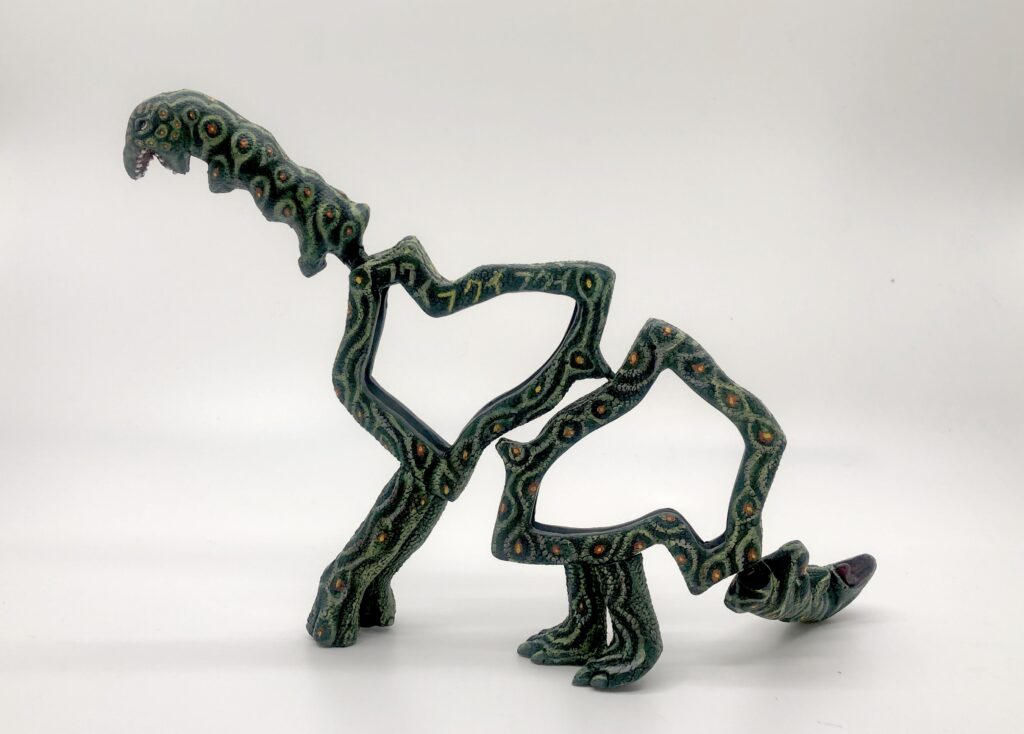
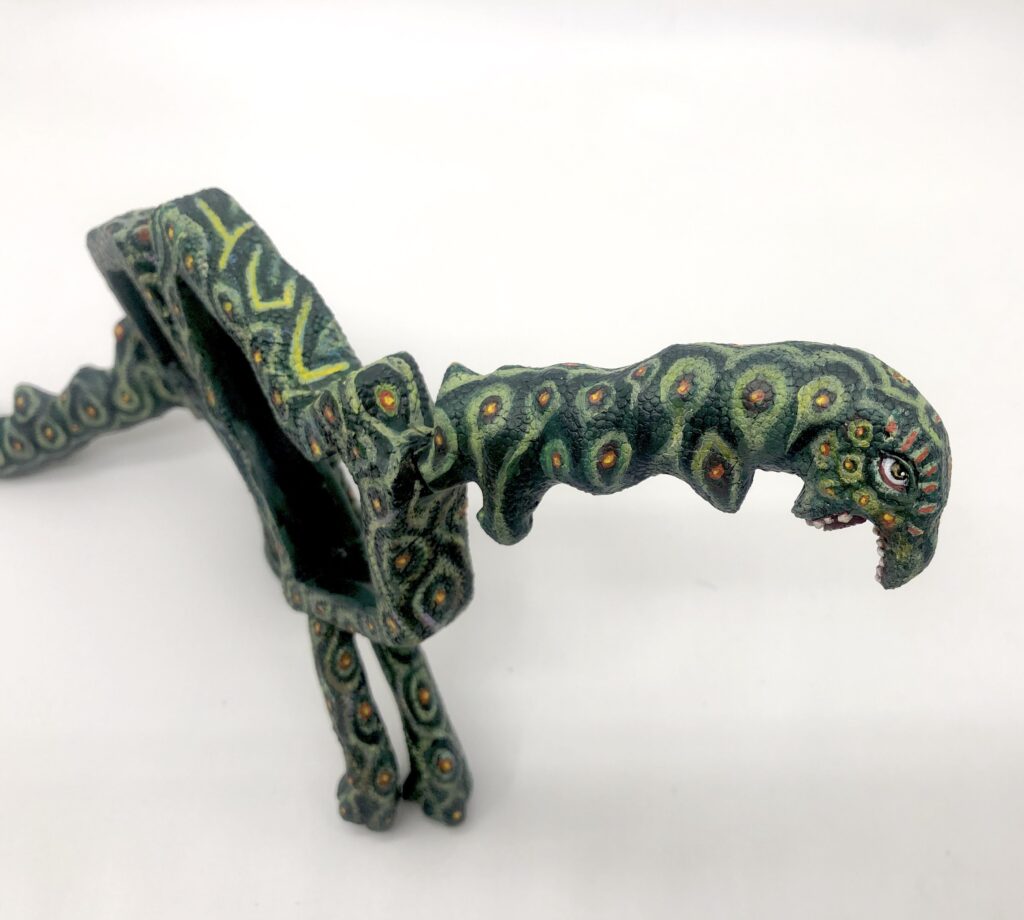
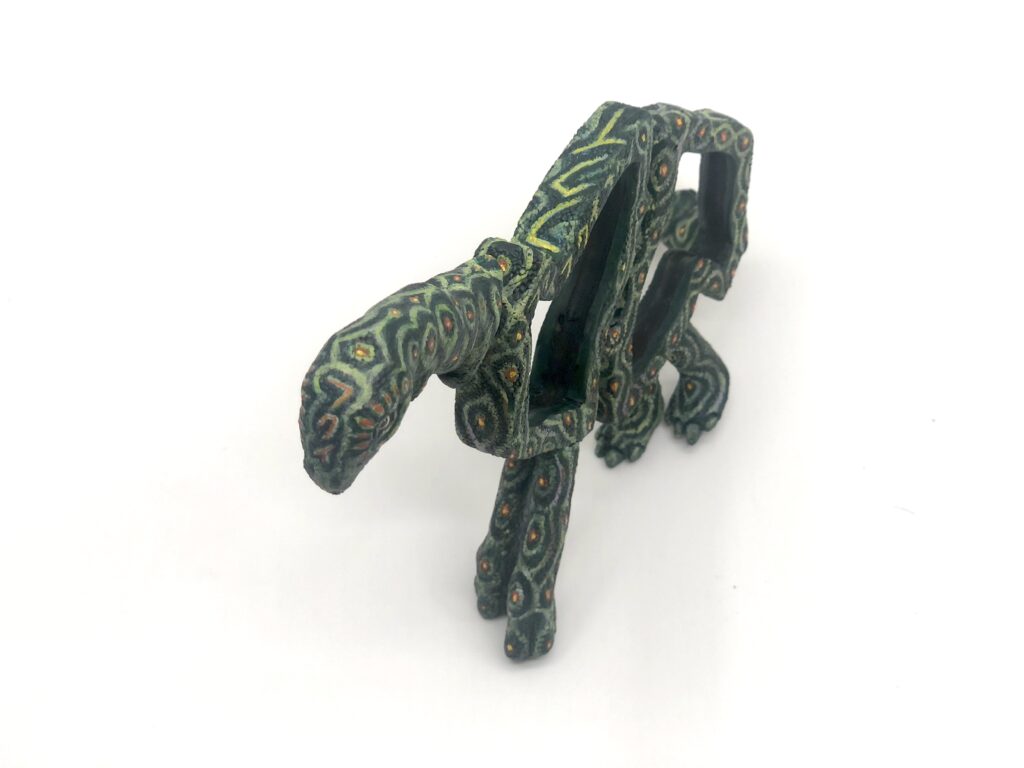
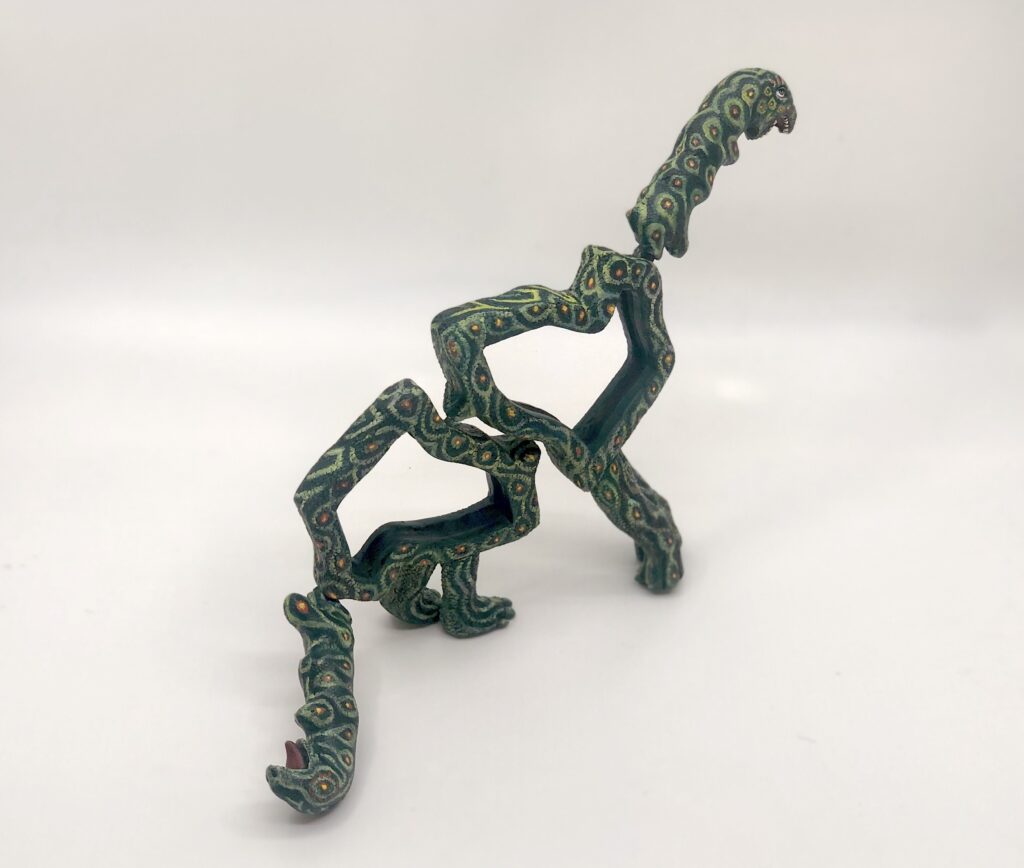
Legal amount : height × width × length =155×325×37(mm)
Materials: Epoxy putty, Sculpey, cardboard, onyx balls, eyeglass parts
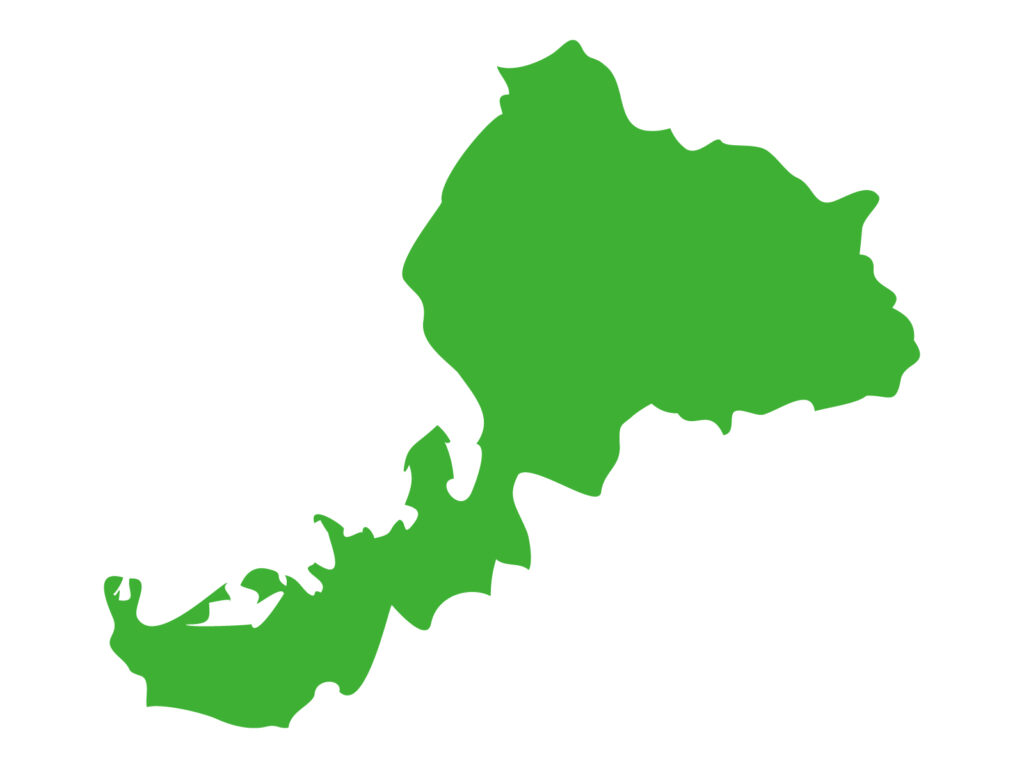
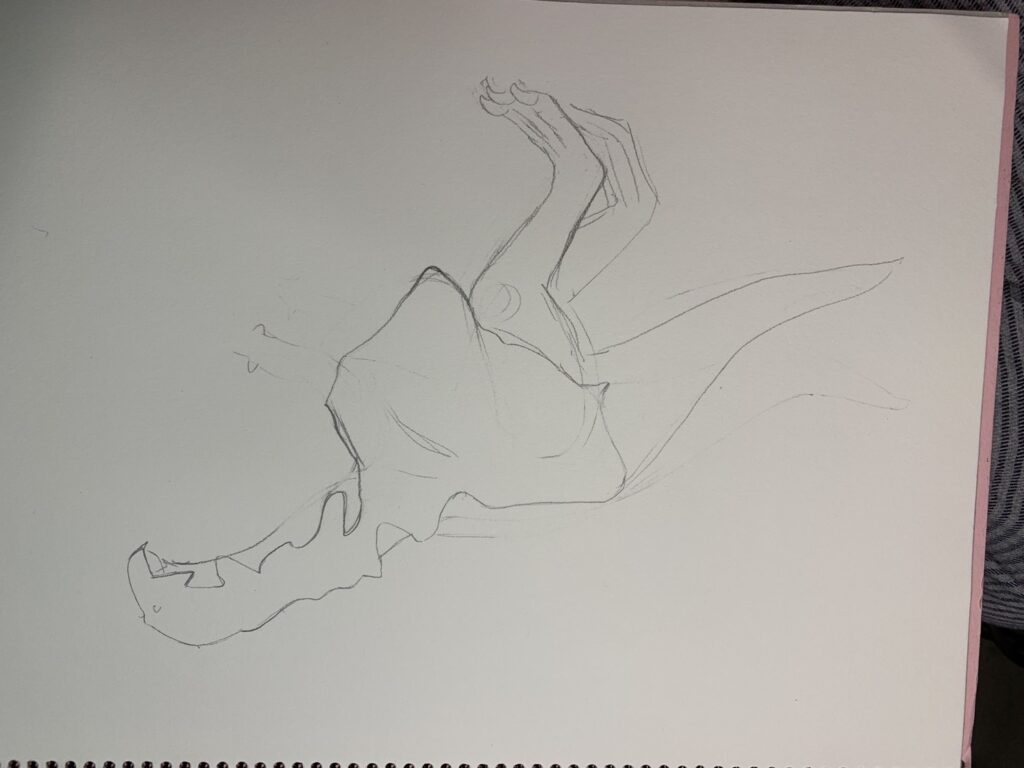
I printed out a deformed image of Fukui Prefecture and tried to make it look like this or that in my sketchbook, but I couldn’t come up with anything.
Then my eldest son came up with this crazy idea. “Why don’t we use two Fukui Prefecture and add arms and legs to make it look like a dinosaur? That reminds me, Fukui is all about dinosaurs! I remember going to the Fukui Prefectural Dinosaur Museum on a family trip once! I loved it there. It’s true that you can make one side of the rias coastline the neck and the other side the tail. If you make legs grow out of it, it looks like a dinosaur! Rather than a Fukuiraptor, it was more like a Fukuititan-type large herbivorous dinosaur.
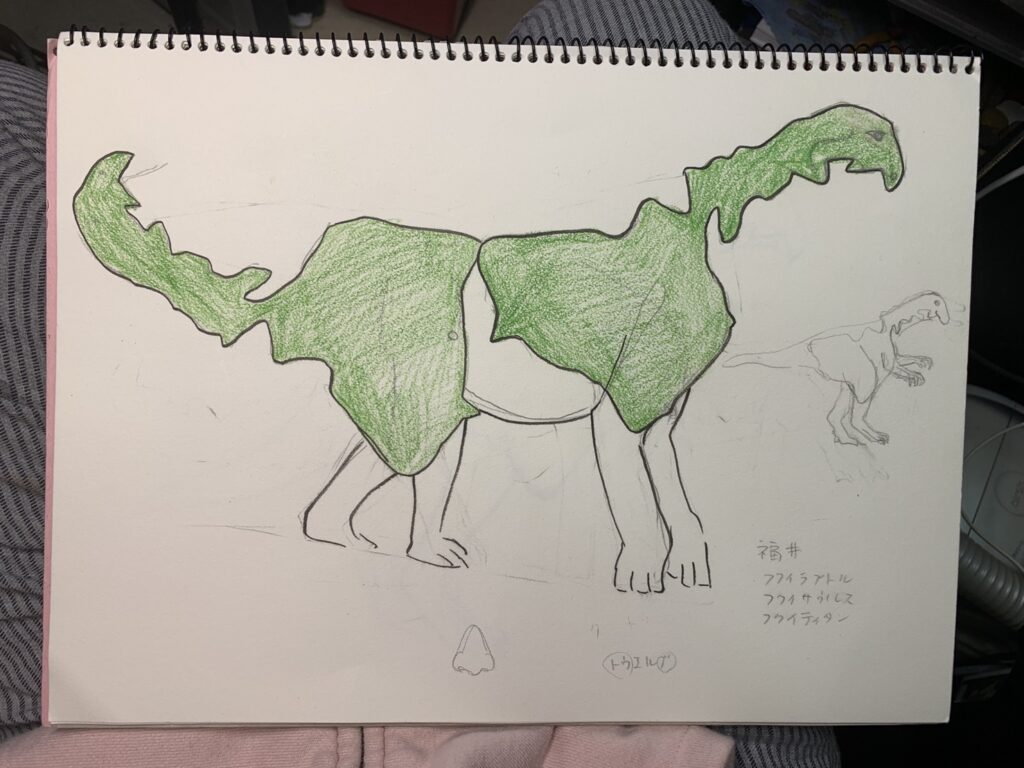
It looked like that when I drew it on the canvas, so I quickly cut out the shape of Fukui Prefecture on a 2mm thick cardboard and put some putty on it. Then, I had a problem: “How thick should it be? That was the problem. If I made the body and neck like a dinosaur, it would be difficult to understand the shape of the prefecture. But if I made it too thin, it would not be powerful enough as a dinosaur.
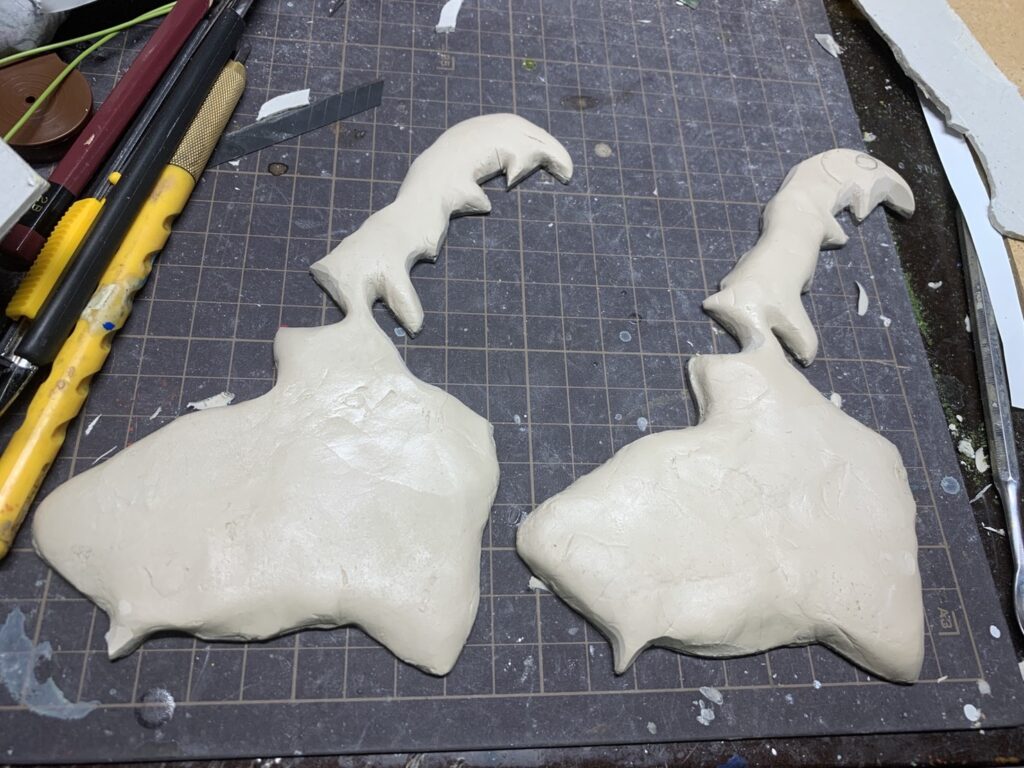
Fukui is also famous for Sabae glasses. I’ve been to Sabae City twice and had my original glasses made there. How about hollowing out the center of Fukui Prefecture and making it into glasses? But two Fukui prefectures would be asymmetrical, so it would be hard to wear… Well, I don’t know what I’m thinking, so let’s just make it! So, I hollowed out the center and started to make a dinosaur.
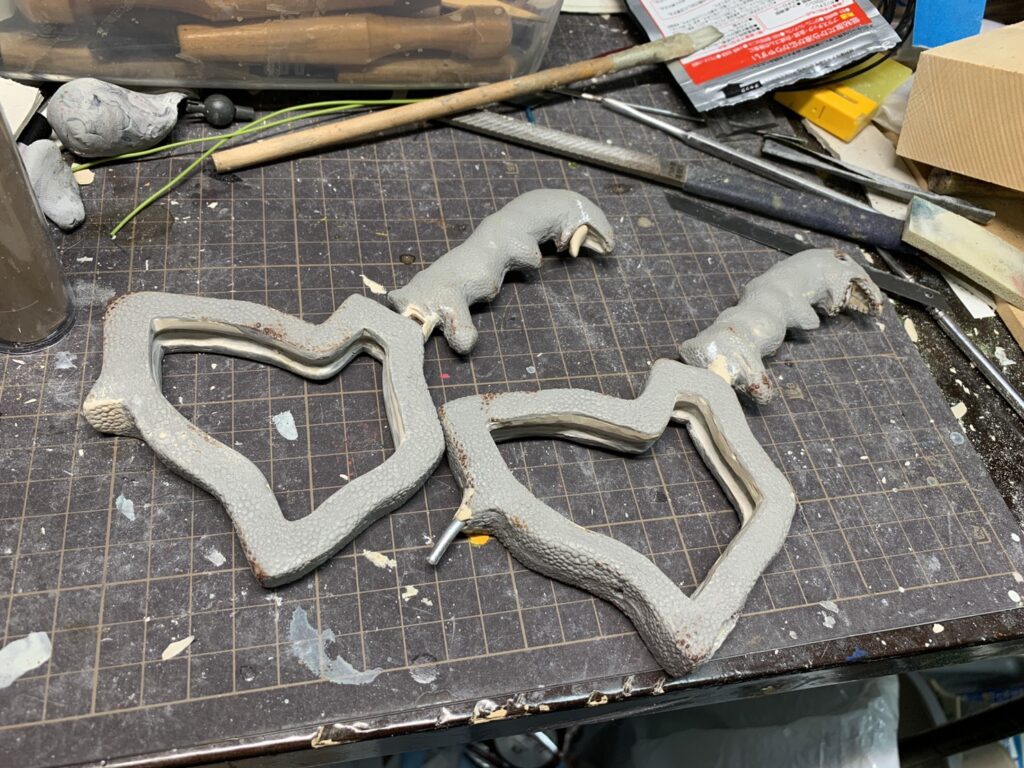
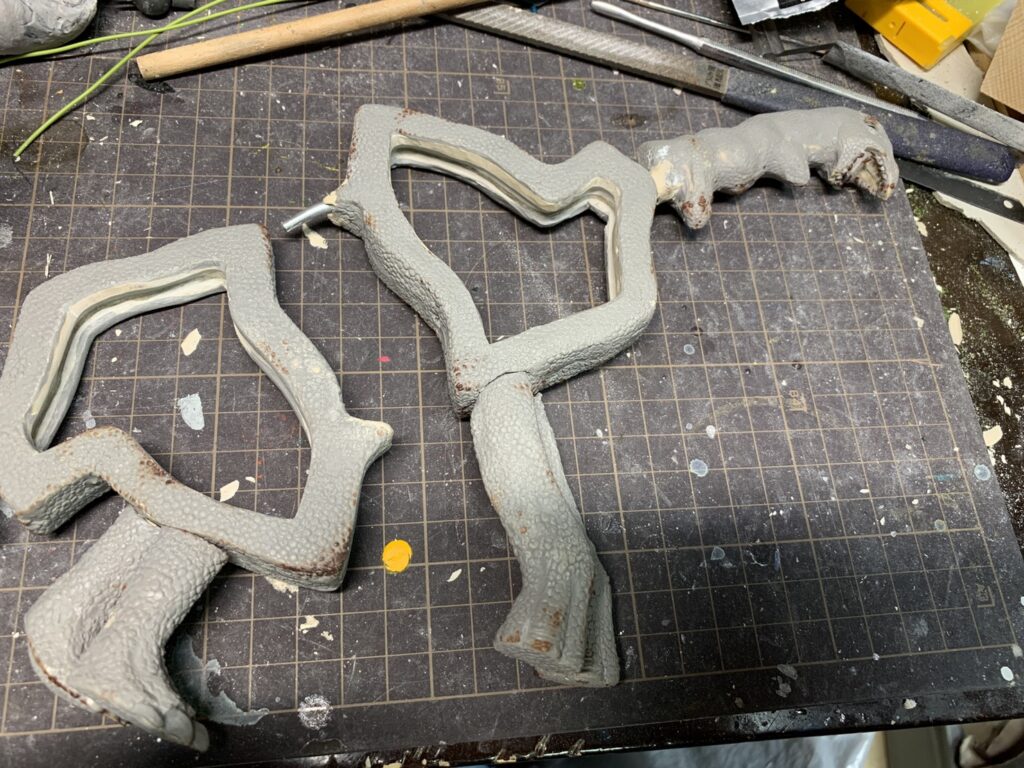
Put onyx beads in the eyeballs, make a neck from the head with the tip as the mouth, and a tail of the same shape. Then, from the body with a hole in the middle, grow thin legs. For the surface, I did what I was good at: I pressed a rubber mold of stingray skin onto the sculpey. There was a lot of surface area for such a flimsy thing, and I had to worry about how much to make the scales on the skin, but I managed to complete an indescribable creature that was thin for a dinosaur but thick for a pair of glasses. The reason why the tail and face are the same is to make the animals think that the tail is the face when they are running away from a carnivorous dragon.
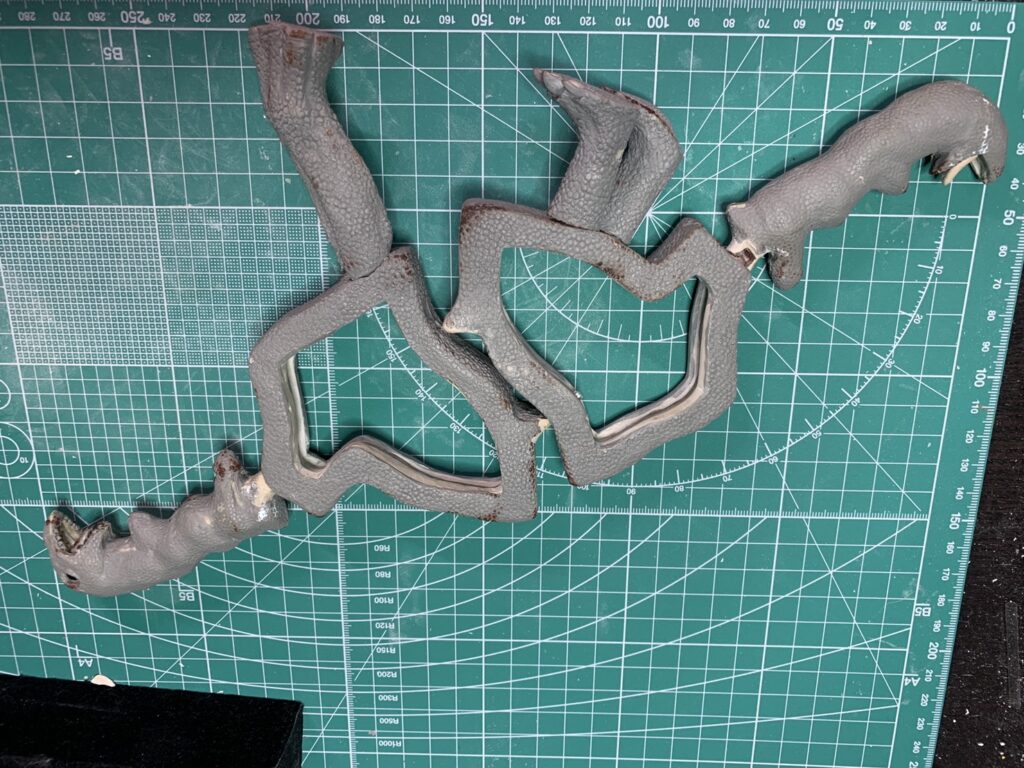
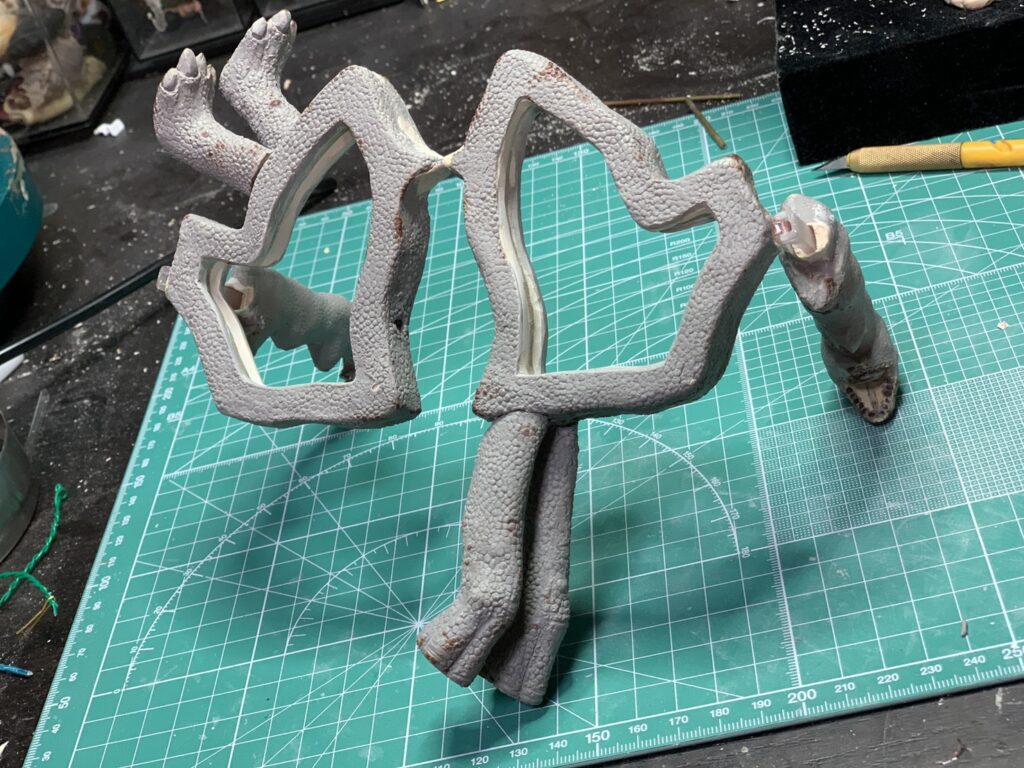
I decided to call this “dinosaur mode,” and devised a “glasses mode” in which the lower half of the body is attached in the opposite direction, using the sharp point of the joint as the axis! I expected to be able to make a nice pair of glasses by attaching hinges to the vines, but the vines were too short to fit over my ears. I put in a joint from an unused pair of glasses I had at home, stretched them a bit, and managed to get them on! But then I made another mistake in setting the length of the vines, and it turned out that they were not long enough…! I wonder if the dinosaur’s neck is too thick to fit over its ears in the first place…
Disgusted with my lack of planning, I decide that if this happens, I can’t wear them over my ears, but I’ll hold the upper legs of the dinosaur in my hands and wear them, the opera glass type glasses used by the aristocracy.

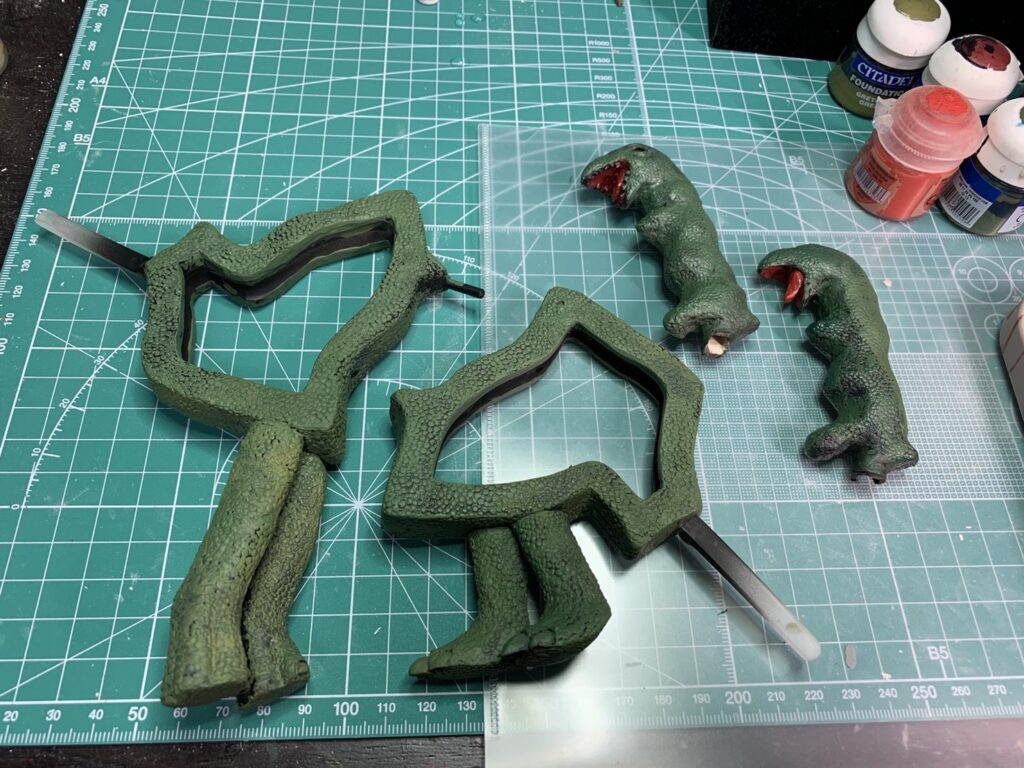
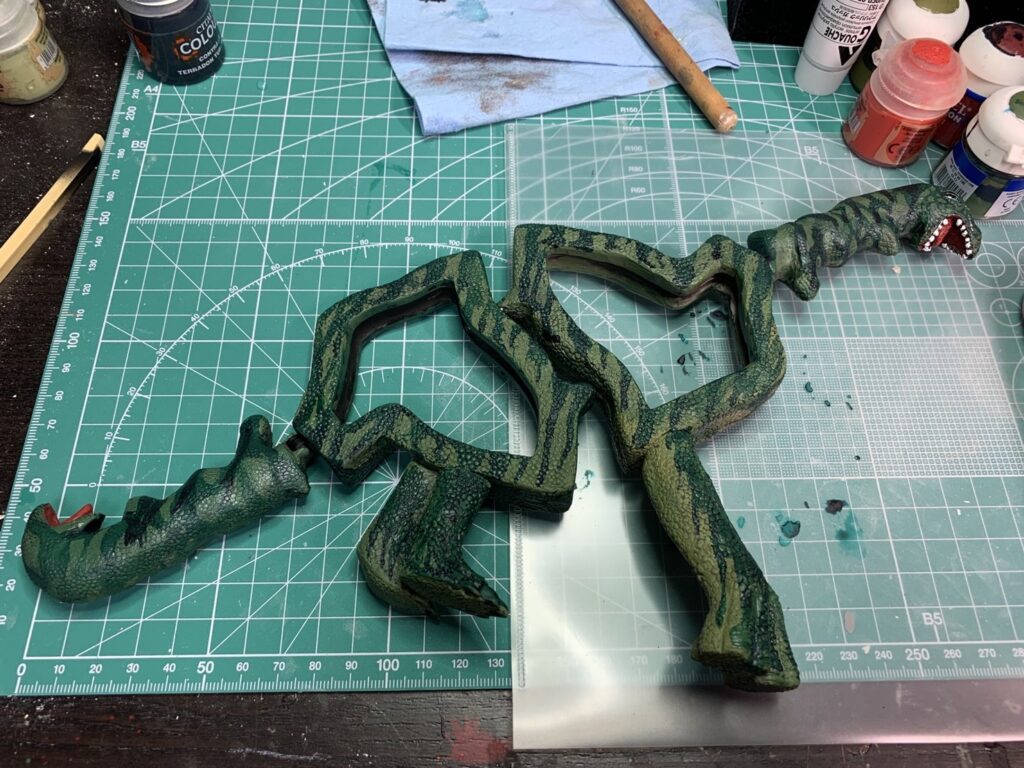
The color of the dinosaur is unknown = Free, so I decided on a camouflage pattern with a green base and the word ” Fukui” in it, painting was fun.
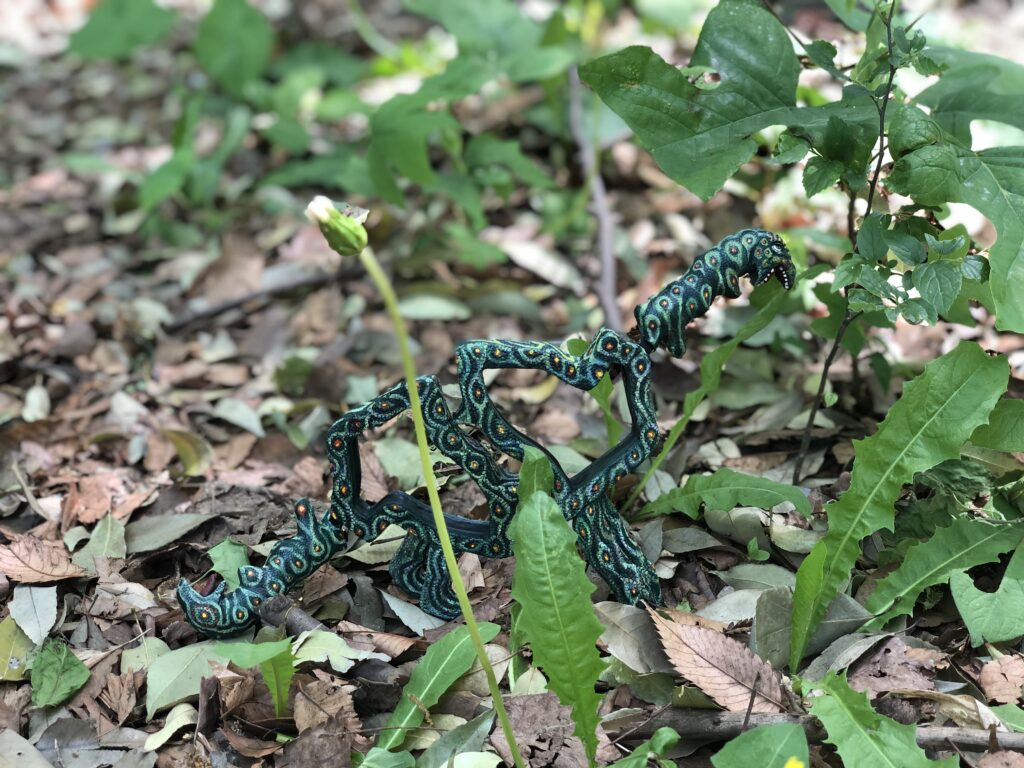
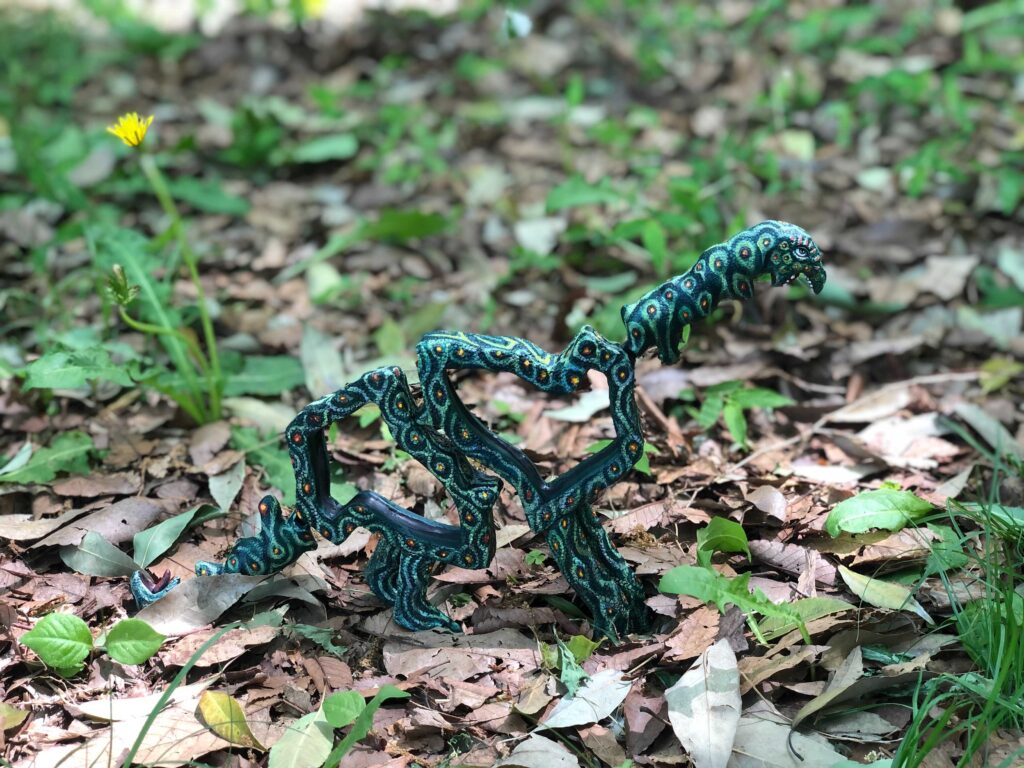
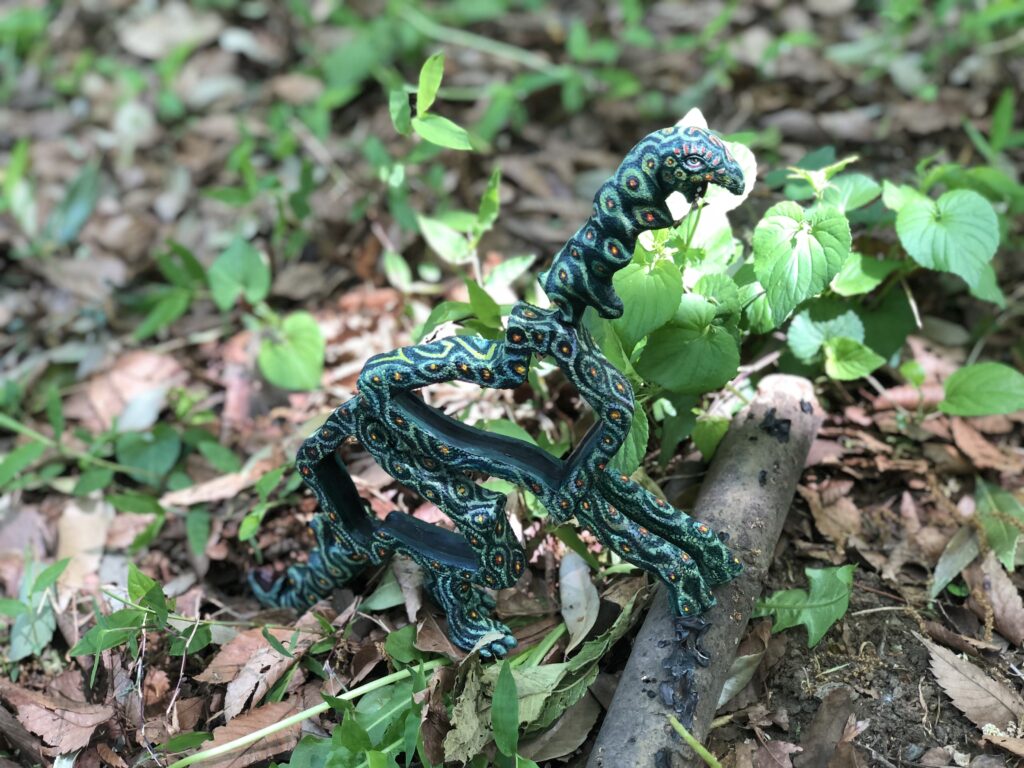

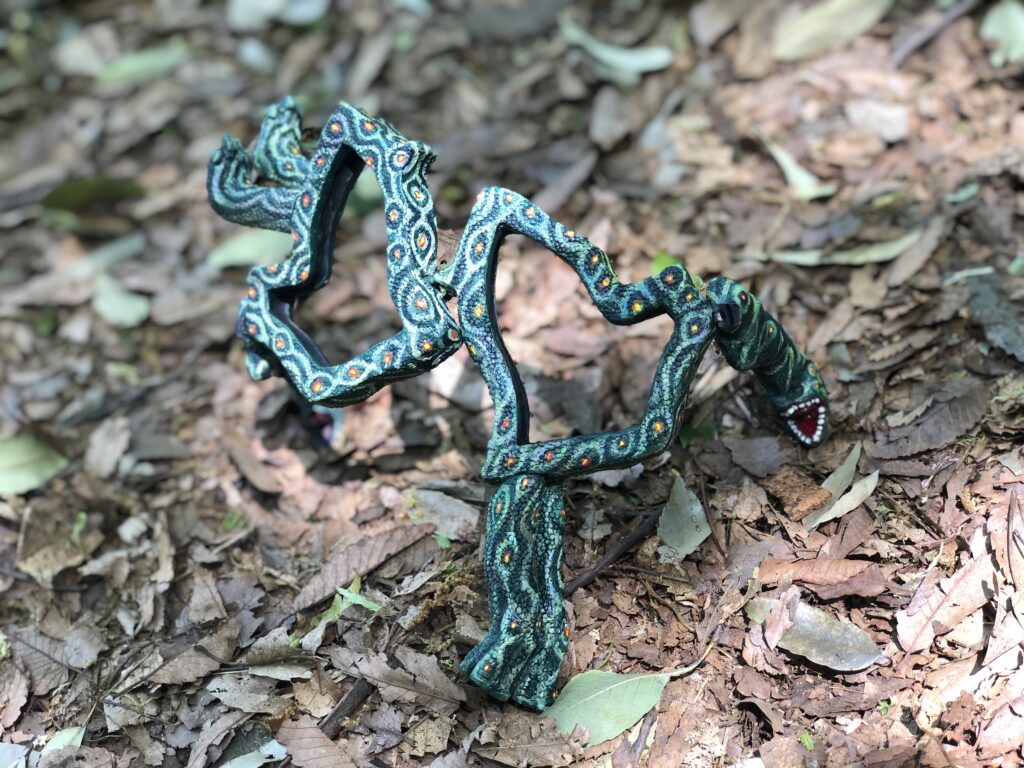
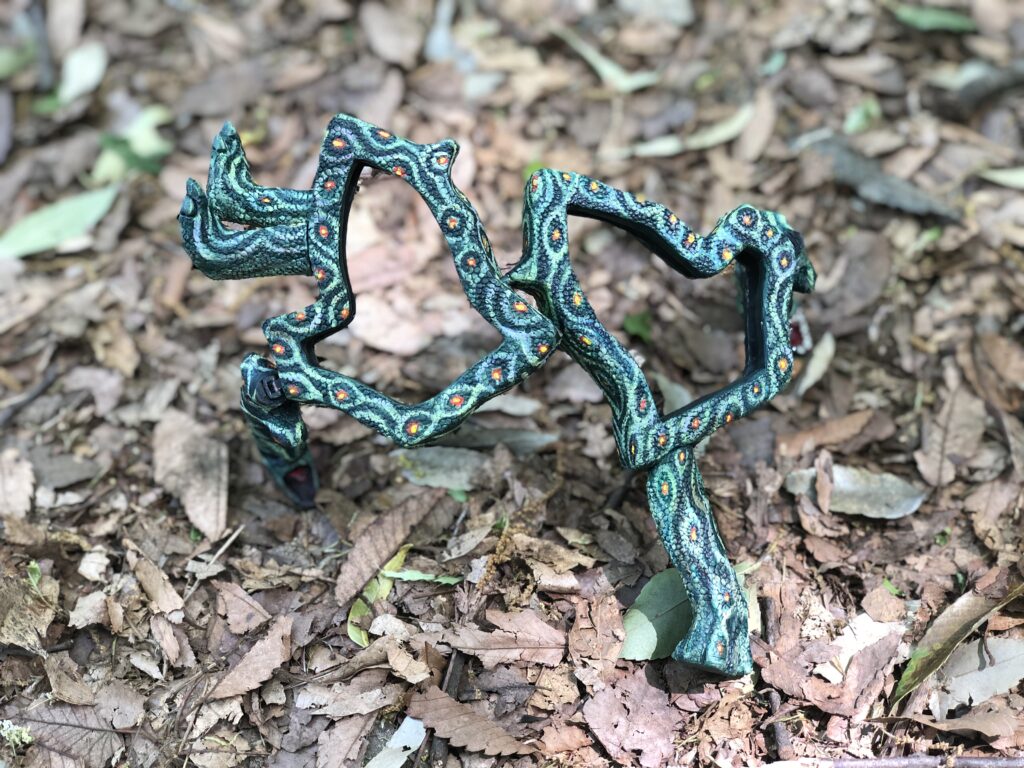
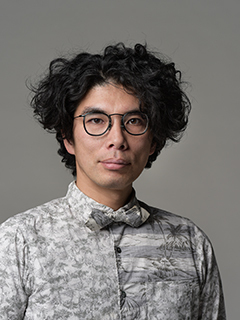
Jin Katagiri
Born November 27, 1973 / Born in Saitama Prefecture / Graduated from Tama Art University
Active in the stage, movies, radio, etc., mainly in TV dramas series. Major appearances in recent years include “99.9% -Criminal Lawyer-” (TBS), “Your Turn to Kill” (NTV), and “NHK Morning drama series Yell” (NHK).
In addition to acting, he also creates clay, and from 2016 to 2018 he held a national tour at the “Jin Katagiri Absurdity Clay Art Exhibit Giri Ten.” In 2019, he is holding his first overseas solo exhibition in Taiwan.
Fukui Prefecture is located on the Sea of Japan side, almost in the center of the Japanese archipelago. Along the coast of the prefecture, there is Tojinbo, *a pillar-shaped joint that is said to be one of the three most beautiful sights in the world. The various rock surfaces are roughly cut by the erosion of waves. It stretches for about one kilometer, and the rough waves of the Sea of Japan crashing against the cliffs are truly dynamic. This is the only place in Japan where you can find such a huge columnar joint of pyroxene andesite, which is geologically valuable and designated as a national natural monument.
※Columnar joints are the columnar fractures that form when magma hardens and the rock shrinks as it cools.
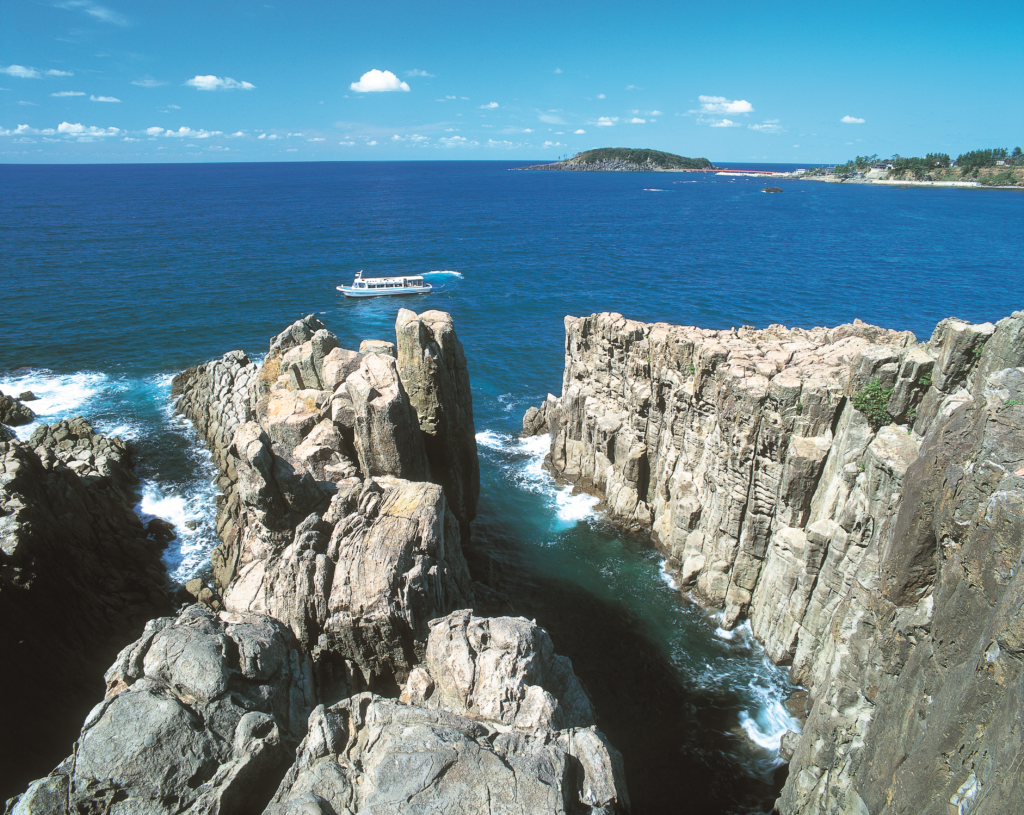
Fukui Prefecture is said to be a beautiful prefecture with an abundance of nature, as expressed in the old saying “Etsuzan Jakusui”, which refers to the beautiful mountains in Echizen Province and the beautiful water (sea and rivers) in Wakasa Province. The population is the 42nd smallest among the 47 prefectures (*2020 survey), but it has been awarded NO.1 in the *”Japan Happiness Ranking” for the fourth time in 2020.
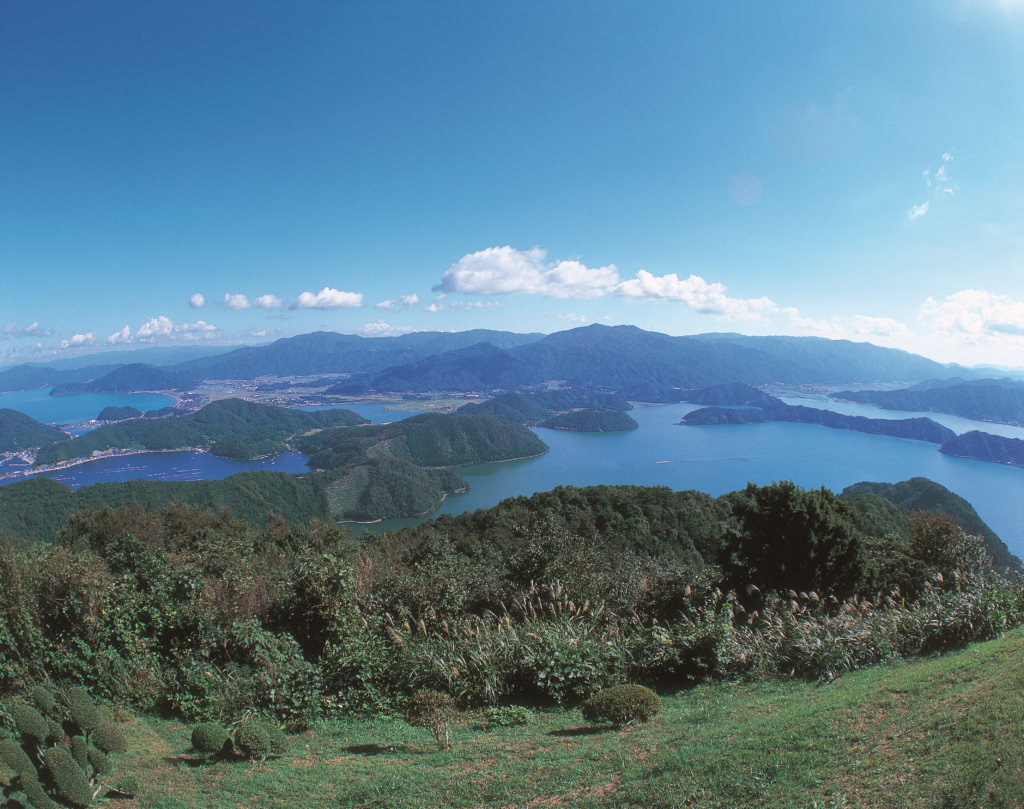
What is the “Happiness Ranking”?
The Japan Research Institute, Inc. publishes the “Happiness Ranking of All 47 Prefectures,” which calculates the level of happiness of each prefecture based on basic indicators such as population growth rate and a total of 75 indicators including indicators by field (health, culture, work, lifestyle, education).
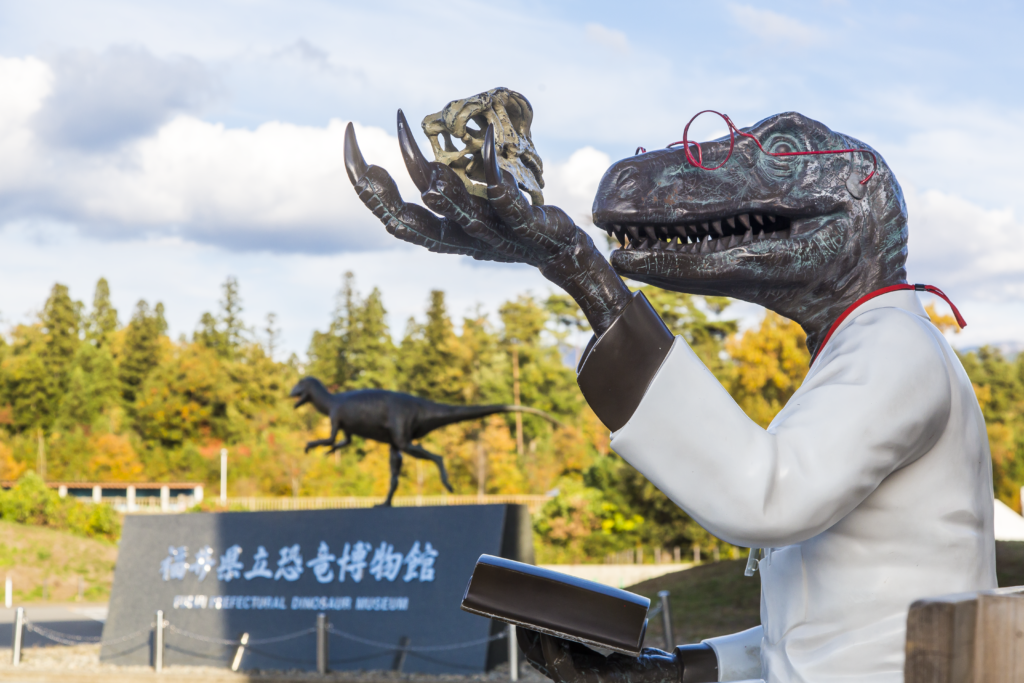
About 80% of the dinosaur fossils excavated in Japan have been found in Fukui Prefecture.
Fukui Prefecture is the largest dinosaur kingdom in Japan, with six dinosaurs that bear the scientific name “Fukui,” such as Fukuiraptor, Fukuisaurus, and Fukuititan.
When you visit the Fukui Prefectural Dinosaur Museum, you can see 44 full-body dinosaur skeletons on display and experience excavation, making it a popular spot for children and adults alike.
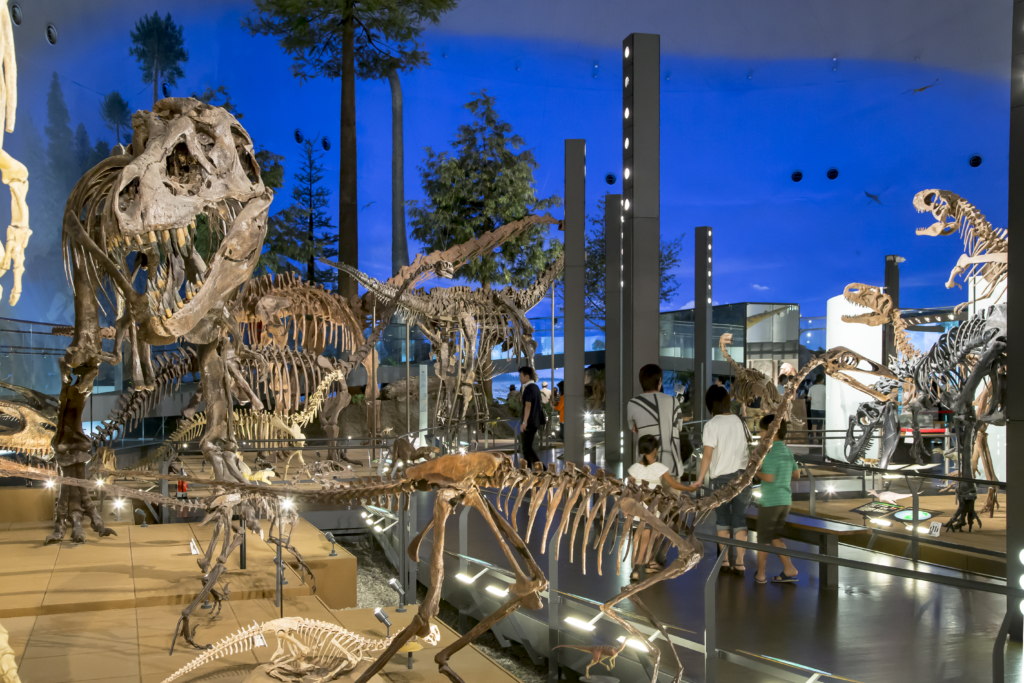
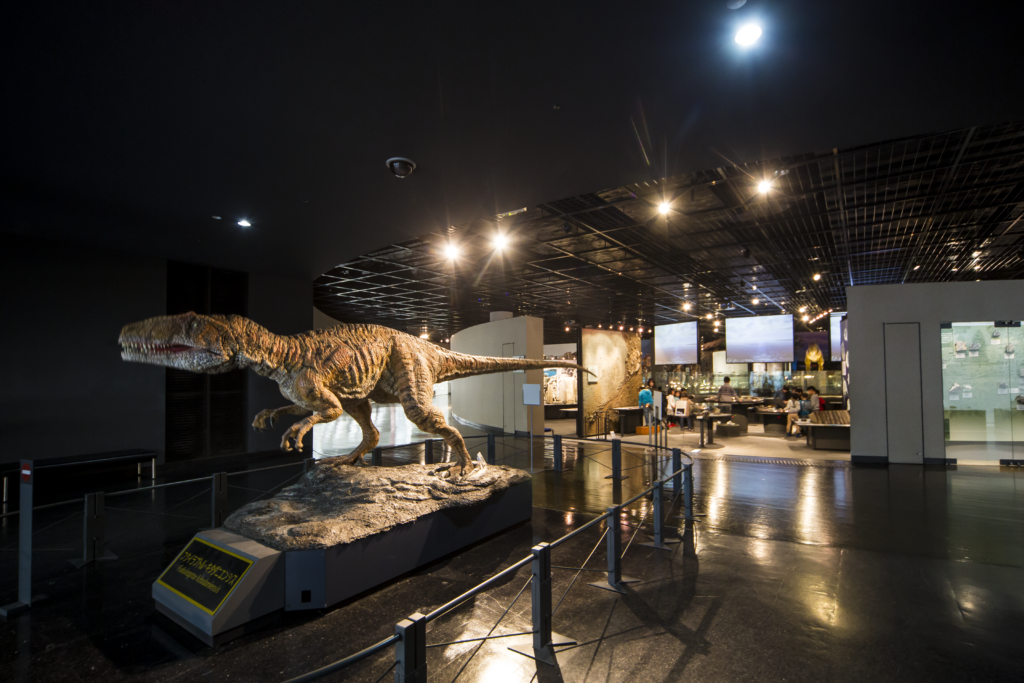
Fukuiraptor
Scientific name : Fukuiraptor kitadaniensis
Classification : Theropoda, Theropoda, Allosauria
Epoch: Mesozoic, Early Cretaceous
Locality : Kitadani-cho, Katsuyama City, Fukui Prefecture
Formation: Kitadani Formation, Tedori Group
The Fukuiraptor was a carnivorous dinosaur discovered during excavations in Fukui Prefecture, and was the first domestic carnivorous dinosaur to have its whole body skeleton restored.
At about 4.2 meters in height, it is one of the smallest of the megaraptors, but this skeleton is supposed to be still in the growth stage, and it may have grown even larger.
The bones of the limbs have been found in a particularly well-preserved condition, and the most distinctive feature is the claws on the forelegs, which are not only large but also very thin laterally, clearly different from those of Allosaurus.
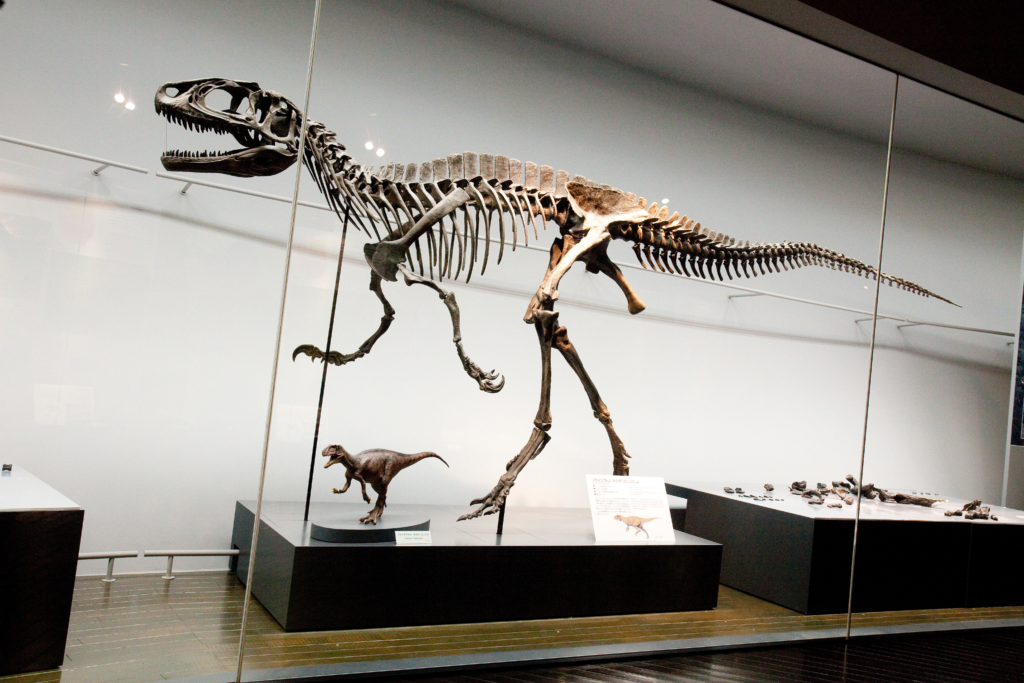
Scientific name: Fukuititan nipponensis
Classification: Titanosauriformes, suborder Theropoda, suborder Theropoda
Epoch: Mesozoic, Early Cretaceous
Locality : Kitadani-cho, Katsuyama City, Fukui Prefecture
Formation: Kitadani Formation, Tedori Group
This is a theropod found at an excavation site in Katsuyama City, Fukui Prefecture.The scientific name of this species is Fukuititan nipponensis, and it was discovered in the summer of 2007 during preparations for the third excavation.It means “Fukui giant from Japan,” and it was the first Japanese dinosaur to be given a scientific name. It is considered to be a primitive titanosaurid, although its overall shape is still a mystery due to the small number of parts found.
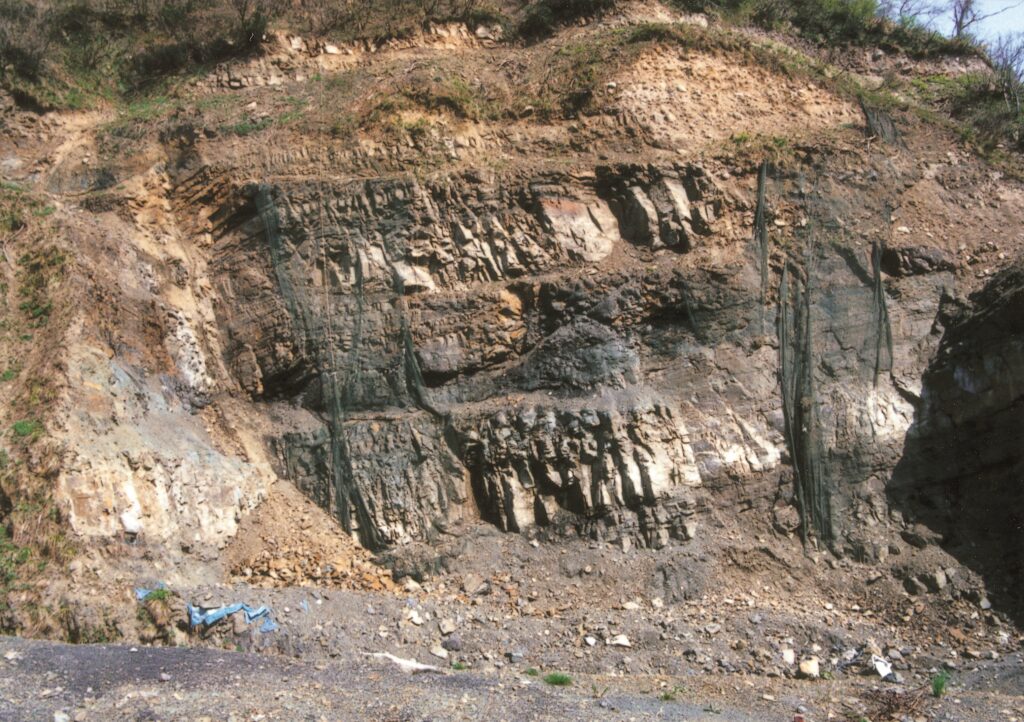
Fukui Prefectural Dinosaur Museum https://www.dinosaur.pref.fukui.jp/en/
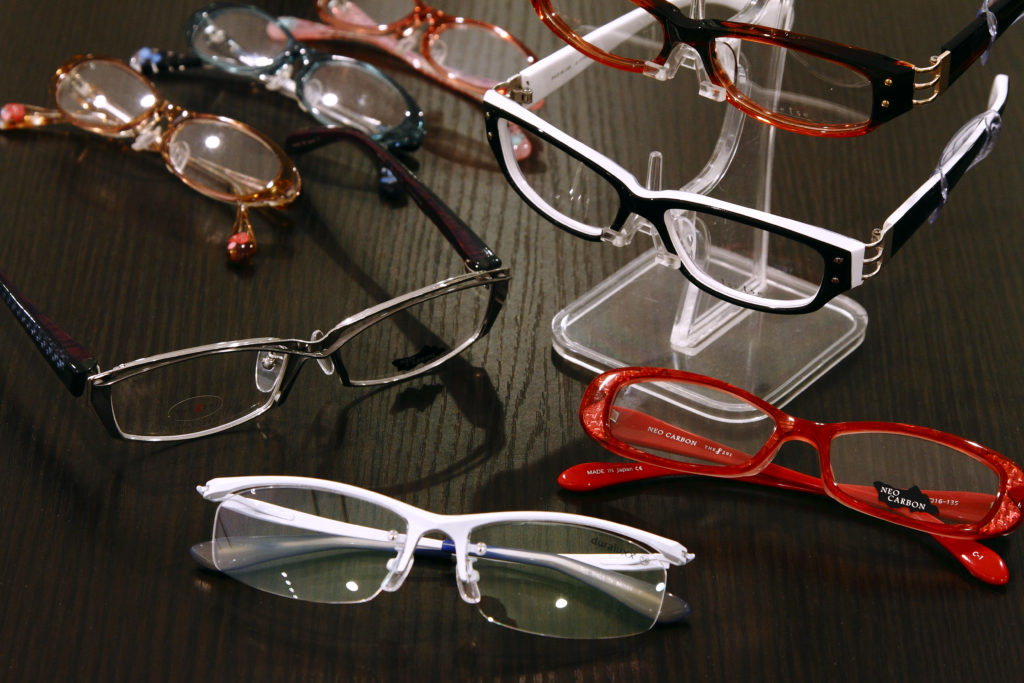
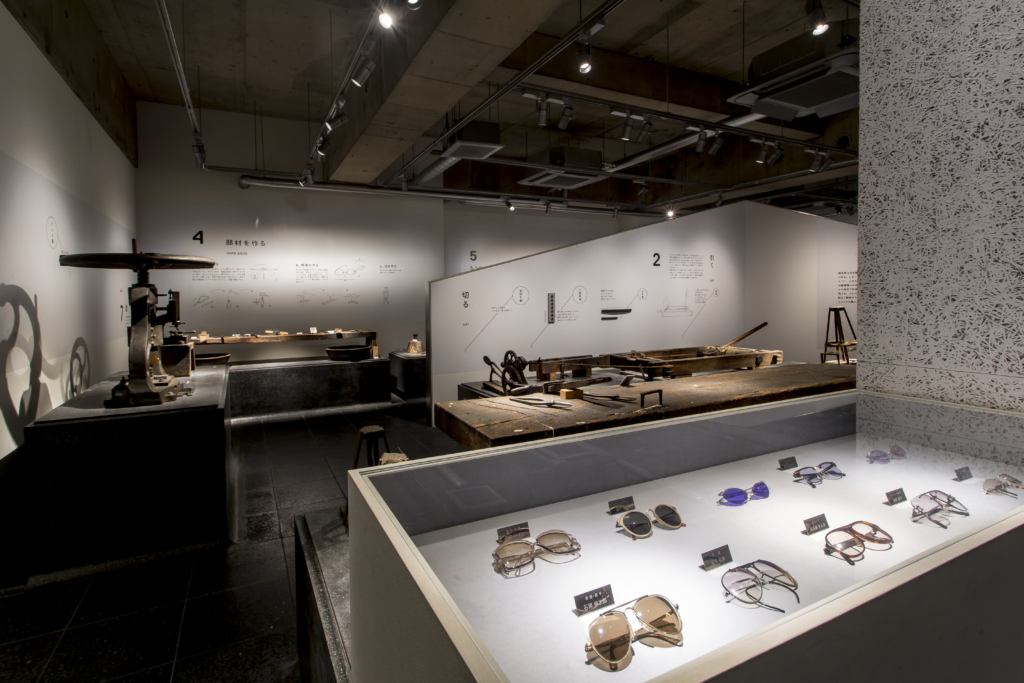
Sabae City in Fukui Prefecture is famous as a world-class producer of eyeglasses, but the roots of this industry began in the neighboring town of Ikuno.
In 1905, a poor farming village was buried under snow in winter, and the desire of Gozaemon Masunaga and his younger brother, Kohachi, to somehow improve life in their hometown of Ikuno, led to the creation of Fukui’s industry.Around that time, demand for eyeglasses increased with the spread of print culture, and eyeglass manufacturing began at Masunaga’s factory and spread from Ikuno to Sabae City, making Fukui and Sabae a major production center, producing *about 95% of all eyeglass frames in Japan.The passion of the craftsmen led to the development of the world’s most technologically advanced eyeglass production area, including the development of the world’s first eyeglass frame made of titanium.
*Reference: Fukui Prefecture Industrial Statistics Survey 2014
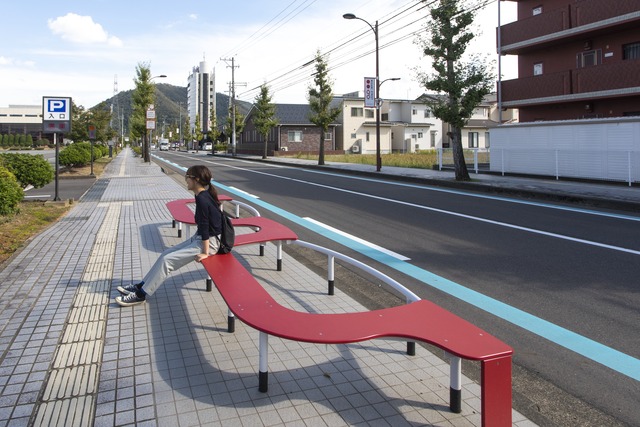
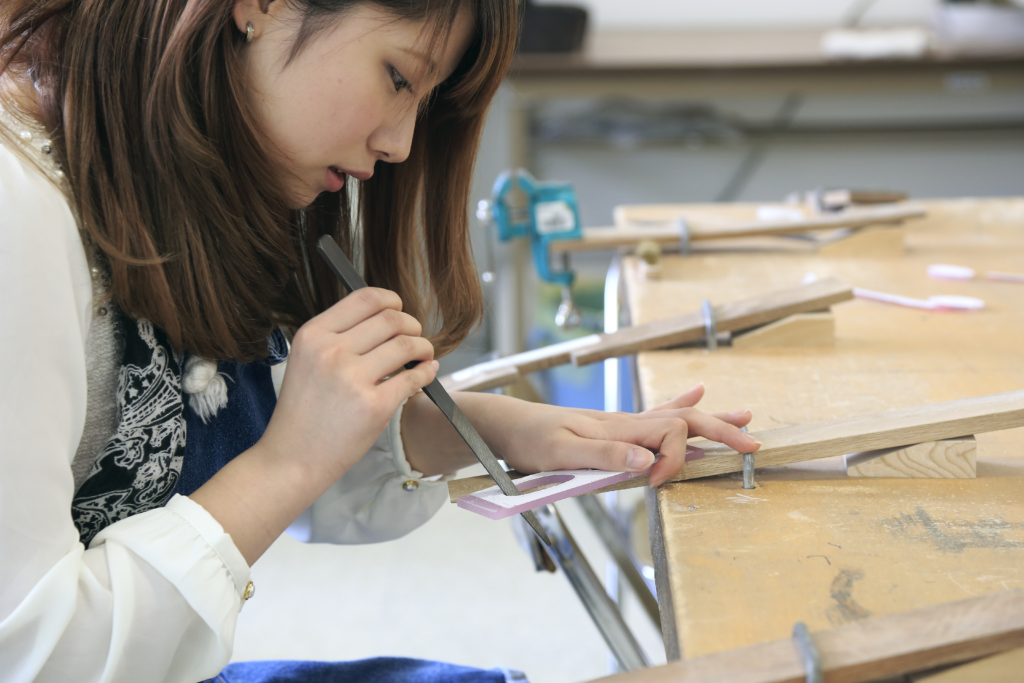
When you go to Sabae, the 1km-long road connecting Sabae Station to the Megane Museum is commonly called “Megane Street,” and is said to be littered with signs, benches, manholes, and other places with designs related to glasses.
At the Megane Museum, there is a “Megane Handcraft Class” where you can make your own original glasses.
For more information about the handcraft class, please contact the Museum in advance.
All images after “About Fukui Prefecture” are provided by Fukui Prefectural Tourism Federation.
References:
・Fukui.com( Fukui Prefectural Tourism Federation )https://www.fuku-e.com/
・ Fukui Prefectural Dinosaur Museum https://www.dinosaur.pref.fukui.jp/
・JAPAN GLASSES FACTORY https://www.japanglasses.jp/
Everyone in the Katagiri family likes to make things. This time, the eldest son’s idea was put to good use. If you watch the Katagiri family’s YouTube channel called “Giri Channel” (https://www.youtube.com/channel/UCifAzjR7Q05jXZ05nNcIilQ/about), you can see how they enjoy making things together. I think it’s interesting to see the side of Katagiri-san as a father.
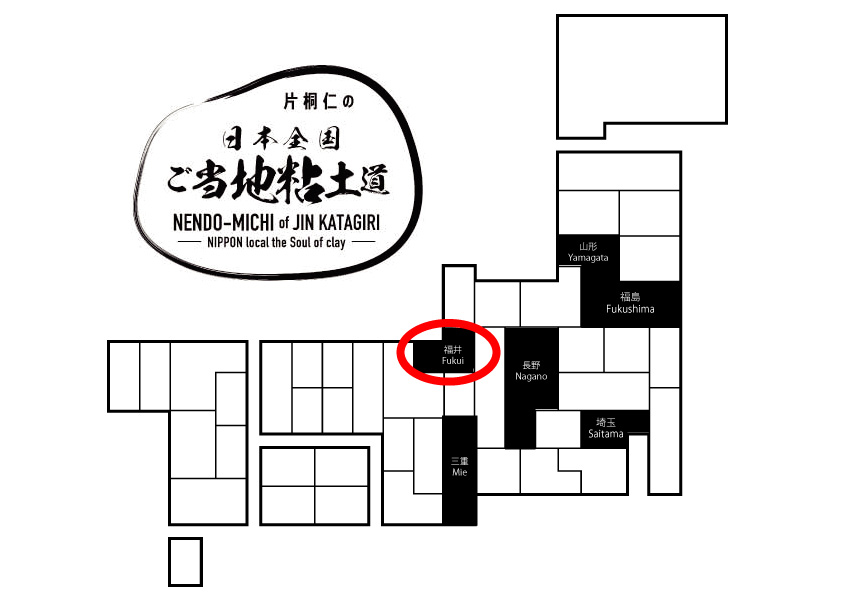
TEXT : THAT IS GOOD Editorial department, Fujita